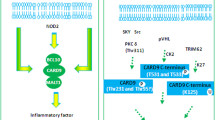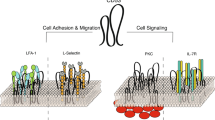Abstract
Genetic mutations in the gene encoding DOCK8 cause an autosomal recessive form of hyper immunoglobulin E syndrome (AR-HIES), referred to as DOCK8 deficiency. DOCK8 deficiency in humans results in the onset of combined immunodeficiency disease (CID), clinically associated with chronic infections with diverse microbial pathogens, and a predisposition to malignancy. It is now becoming clear that DOCK8 regulates the function of diverse immune cell sub-types, particularly lymphocytes, to drive both innate and adaptive immune responses. Early studies demonstrated that DOCK8 is required for lymphocyte survival, migration and immune synapse formation, which translates to poor pathogen control in the absence of DOCK8. However, more recent advances have pointed to a crucial role for DOCK8 in regulating the signal transduction events that control transcriptional activity, cytokine production and functional polarization of immune cells. Here, we summarize recent advances in our understanding of DOCK8 function, paying particular attention to an emerging role as a signaling intermediate to promote immune responses to diverse external stimuli.


Similar content being viewed by others
References
Cote JF, Vuori K . Identification of an evolutionarily conserved superfamily of DOCK180-related proteins with guanine nucleotide exchange activity. J Cell Sci 2002; 115: 4901–4913.
Meller N, Merlot S, Guda C . CZH proteins: a new family of Rho-GEFs. J Cell Sci 2005; 118: 4937–4946.
Cote JF, Motoyama AB, Bush JA, Vuori K . A novel and evolutionarily conserved PtdIns(3,4,5)P3-binding domain is necessary for DOCK180 signalling. Nat Cell Biol 2005; 7: 797–807.
Hara S, Kiyokawa E, Iemura S, Natsume T, Wassmer T, Cullen PJ et al. The DHR1 domain of DOCK180 binds to SNX5 and regulates cation-independent mannose 6-phosphate receptor transport. Mol Biol Cell 2008; 19: 3823–3835.
Zhang Q, Davis JC, Lamborn IT, Freeman AF, Jing H, Favreau AJ et al. Combined immunodeficiency associated with DOCK8 mutations. N Engl J Med 2009; 361: 2046–2055.
Engelhardt KR, McGhee S, Winkler S, Sassi A, Woellner C, Lopez-Herrera G et al. Large deletions and point mutations involving the dedicator of cytokinesis 8 (DOCK8) in the autosomal-recessive form of hyper-IgE syndrome. J Allergy Clin Immunol 2009; 124: 1289–302 e4.
Randall KL, Lambe T, Johnson AL, Treanor B, Kucharska E, Domaschenz H et al. Dock8 mutations cripple B cell immunological synapses, germinal centers and long-lived antibody production. Nat Immunol 2009; 10: 1283–1291.
Engelhardt KR, Gertz ME, Keles S, Schaffer AA, Sigmund EC, Glocker C et al. The extended clinical phenotype of 64 patients with dedicator of cytokinesis 8 deficiency. J Allergy Clin Immunol 2015; 136: 402–412.
Su HC . Dedicator of cytokinesis 8 (DOCK8) deficiency. Curr Opin Allergy Clin Immunol 2010; 10: 515–520.
Aydin SE, Kilic SS, Aytekin C, Kumar A, Porras O, Kainulainen L et al. DOCK8 deficiency: clinical and immunological phenotype and treatment options—a review of 136 patients. J Clin Immunol 2015; 35: 189–198.
Kearney CJ, Brennan AJ, Darcy PK, Oliaro J . The role of the immunological synapse formed by cytotoxic lymphocytes in immunodeficiency and anti-tumor immunity. Crit Rev Immunol 2015; 35: 325–347.
Dustin ML . The immunological synapse. Cancer Immunol Res 2014; 2: 1023–1033.
Dustin ML . Membrane domains and the immunological synapse: keeping T cells resting and ready. J Clin Invest 2002; 109: 155–160.
Orange JS . Formation and function of the lytic NK-cell immunological synapse. Nat Rev Immunol 2008; 8: 713–725.
Rohatgi R, Ho HY, Kirschner MW . Mechanism of N-WASP activation by CDC42 and phosphatidylinositol 4, 5-bisphosphate. J Cell Biol 2000; 150: 1299–1310.
Carrasco YR, Fleire SJ, Cameron T, Dustin ML, Batista FD . LFA-1/ICAM-1 interaction lowers the threshold of B cell activation by facilitating B cell adhesion and synapse formation. Immunity 2004; 20: 589–599.
Yuseff MI, Pierobon P, Reversat A, Lennon-Dumenil AM . How B cells capture, process and present antigens: a crucial role for cell polarity. Nat Rev Immunol 2013; 13: 475–486.
Zhang Y, Wang H . Integrin signalling and function in immune cells. Immunology 2012; 135: 268–275.
Arana E, Harwood NE, Batista FD . Regulation of integrin activation through the B-cell receptor. J Cell Sci 2008; 121: 2279–2286.
Randall KL, Chan SS, Ma CS, Fung I, Mei Y, Yabas M et al. DOCK8 deficiency impairs CD8 T cell survival and function in humans and mice. J Exp Med 2011; 208: 2305–2320.
Lambe T, Crawford G, Johnson AL, Crockford TL, Bouriez-Jones T, Smyth AM et al. DOCK8 is essential for T-cell survival and the maintenance of CD8+ T-cell memory. Eur J Immunol 2011; 41: 3423–3435.
Mizesko MC, Banerjee PP, Monaco-Shawver L, Mace EM, Bernal WE, Sawalle-Belohradsky J et al. Defective actin accumulation impairs human natural killer cell function in patients with dedicator of cytokinesis 8 deficiency. J Allergy Clin Immunol 2013; 131: 840–848.
Ham H, Guerrier S, Kim J, Schoon RA, Anderson EL, Hamann MJ et al. Dedicator of cytokinesis 8 interacts with talin and Wiskott-Aldrich syndrome protein to regulate NK cell cytotoxicity. J Immunol 2013; 190: 3661–3669.
Mou F, Praskova M, Xia F, Van Buren D, Hock H, Avruch J et al. The Mst1 and Mst2 kinases control activation of rho family GTPases and thymic egress of mature thymocytes. J Exp Med 2012; 209: 741–759.
Zhang Q, Dove CG, Hor JL, Murdock HM, Strauss-Albee DM, Garcia JA et al. DOCK8 regulates lymphocyte shape integrity for skin antiviral immunity. J Exp Med 2014; 211: 2549–2566.
Harada Y, Tanaka Y, Terasawa M, Pieczyk M, Habiro K, Katakai T et al. DOCK8 is a Cdc42 activator critical for interstitial dendritic cell migration during immune responses. Blood 2012; 119: 4451–4461.
Krishnaswamy JK, Singh A, Gowthaman U, Wu R, Gorrepati P, Sales Nascimento M et al. Coincidental loss of DOCK8 function in NLRP10-deficient and C3H/HeJ mice results in defective dendritic cell migration. Proc Natl Acad Sci USA 2015; 112: 3056–3061.
Calabro S, Liu D, Gallman A, Nascimento MS, Yu Z, Zhang TT et al. Differential Intrasplenic Migration of Dendritic Cell Subsets Tailors Adaptive Immunity. Cell Rep 2016; 16: 2472–2485.
Shiraishi A, Uruno T, Sanematsu F, Ushijima M, Sakata D, Hara T et al. DOCK8 Regulates Macrophage Migration through Cdc42 Activation and LRAP35a Interaction. J Biol Chem 2016; 292: 2191–2202.
Xu X, Han L, Zhao G, Xue S, Gao Y, Xiao J et al. LRCH1 interferes with DOCK8-Cdc42-induced T cell migration and ameliorates experimental autoimmune encephalomyelitis. J Exp Med 2017; 214: 209–226.
Martins R, Maier J, Gorki AD, Huber KV, Sharif O, Starkl P et al. Heme drives hemolysis-induced susceptibility to infection via disruption of phagocyte functions. Nat Immunol 2016; 17: 1361–1372.
Janssen E, Tohme M, Hedayat M, Leick M, Kumari S, Ramesh N et al. A DOCK8-WIP-WASp complex links T cell receptors to the actin cytoskeleton. J Clin Invest 2016; 126: 3837–3851.
Crawford G, Enders A, Gileadi U, Stankovic S, Zhang Q, Lambe T et al. DOCK8 is critical for the survival and function of NKT cells. Blood 2013; 122: 2052–2061.
Singh AK, Eken A, Fry M, Bettelli E, Oukka M . DOCK8 regulates protective immunity by controlling the function and survival of RORgammat+ ILCs. Nat Commun 2014; 5: 4603.
Mogensen TH . STAT3 and the Hyper-IgE syndrome: clinical presentation, genetic origin, pathogenesis, novel findings and remaining uncertainties. JAKSTAT 2013; 2: e23435.
Boos AC, Hagl B, Schlesinger A, Halm BE, Ballenberger N, Pinarci M et al. Atopic dermatitis, STAT3- and DOCK8-hyper-IgE syndromes differ in IgE-based sensitization pattern. Allergy 2014; 69: 943–953.
Tangye SG, Pillay B, Randall KL, Avery DT, Phan TG, Gray P et al. Dedicator of cytokinesis 8-deficient CD4+ T cells are biased to a TH2 effector fate at the expense of TH1 and TH17 cells. J Allergy Clin Immunol 2016.
Keles S, Charbonnier LM, Kabaleeswaran V, Reisli I, Genel F, Gulez N et al. Dedicator of cytokinesis 8 regulates signal transducer and activator of transcription 3 activation and promotes TH17 cell differentiation. J Allergy Clin Immunol 2016; 138: 1384–1394 e2.
Yamamura K, Uruno T, Shiraishi A, Tanaka Y, Ushijima M, Nakahara T et al. The transcription factor EPAS1 links DOCK8 deficiency to atopic skin inflammation via IL-31 induction. Nat Commun 2017; 8: 13946.
Jabara HH, McDonald DR, Janssen E, Massaad MJ, Ramesh N, Borzutzky A et al. DOCK8 functions as an adaptor that links TLR-MyD88 signaling to B cell activation. Nat Immunol 2012; 13: 612–620.
Kulkarni K, Yang J, Zhang Z, Barford D . Multiple factors confer specific Cdc42 and Rac protein activation by dedicator of cytokinesis (DOCK) nucleotide exchange factors. J Biol Chem 2011; 286: 25341–25351.
Cook DR, Rossman KL, Der CJ . Rho guanine nucleotide exchange factors: regulators of Rho GTPase activity in development and disease. Oncogene 2014; 33: 4021–4035.
Nishikimi A, Meller N, Uekawa N, Isobe K, Schwartz MA, Maruyama M . Zizimin2: a novel, DOCK180-related Cdc42 guanine nucleotide exchange factor expressed predominantly in lymphocytes. FEBS Lett 2005; 579: 1039–1046.
Author information
Authors and Affiliations
Corresponding author
Ethics declarations
Competing interests
The authors declare no conflict of interest.
Rights and permissions
About this article
Cite this article
Kearney, C., Randall, K. & Oliaro, J. DOCK8 regulates signal transduction events to control immunity. Cell Mol Immunol 14, 406–411 (2017). https://doi.org/10.1038/cmi.2017.9
Received:
Revised:
Accepted:
Published:
Issue Date:
DOI: https://doi.org/10.1038/cmi.2017.9
- Springer Nature Limited
Keywords
This article is cited by
-
A chronic pro-inflammatory environment contributes to the physiopathology of actinic lentigines
Scientific Reports (2024)
-
Non-additive QTL mapping of lactation traits in 124,000 cattle reveals novel recessive loci
Genetics Selection Evolution (2022)
-
dock8 deficiency attenuates microglia colonization in early zebrafish larvae
Cell Death Discovery (2022)
-
The transcription factor CREB1 is a mechanistic driver of immunogenicity and reduced HIV-1 acquisition following ALVAC vaccination
Nature Immunology (2021)
-
Impact of extracellular matrix stiffness on genomic heterogeneity in MYCN-amplified neuroblastoma cell line
Journal of Experimental & Clinical Cancer Research (2020)




